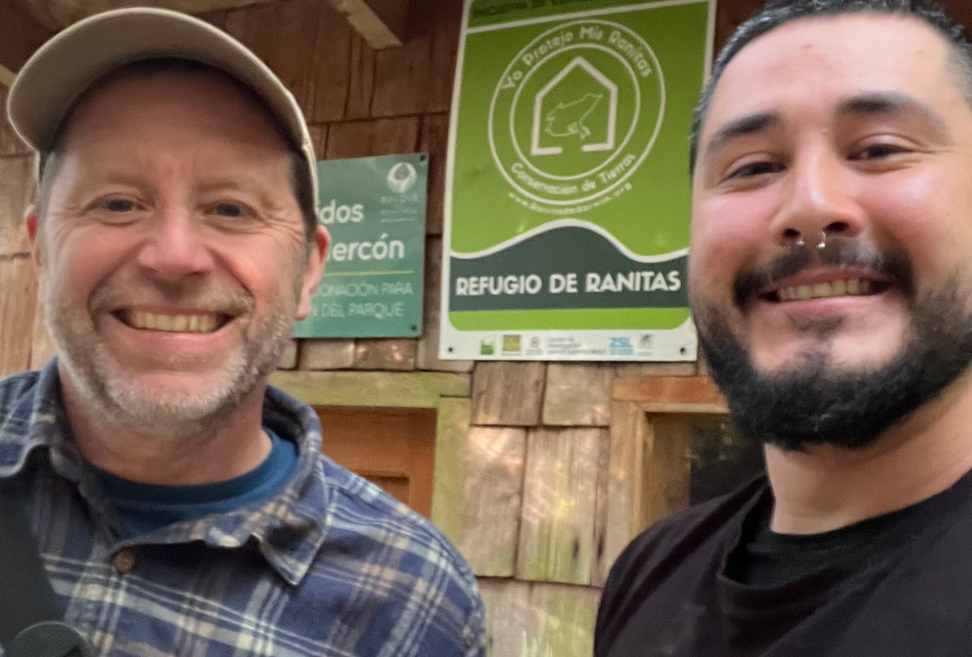


Land Conservation Program
Yo Protejo Mis Ranitas

Colaboran





In Chile72%
of AMPHIBIANS
are ENDEMIC. They are not found anywhere else! and A similar percentage of species are threatened with extinction.
 |  |  |
|---|---|---|
 |  |  |
 |  |  |
 |  |  |
The land owners can help
One of the main threats to amphibians is the destruction and degradation of their habitat. The NGO Ranita de Darwin invites landowners in the country to protect the frogs by creating conservation agreements on their land.
Together we can save the frogs of Chile!
Frog Conservation Agreements/ Frog Conservation Agreements
They are voluntary or legally binding commitments in which a landowner agrees to protect the natural environment on their property. This involves maintaining ecological conditions and refraining from activities that could harm amphibian habitats.
Under the Frog Land Conservation Initiative, property owners have the option to establish one of three types of agreements:

Frog friendly property /Frog friendly land
The landowners commit to adopting measures to protect amphibian habitats on their land. This commitment is formalised through a document, a map, and signage.

Frog Shelter /frog haven
A conservation area accredited by the NGO Ranita de Darwin. The commitment to protect amphibian habitats is formalised through an agreement between the landowners and the NGO. We will support the landowners by conducting annual monitoring of amphibian presence on the property and assessing the implementation of conservation measures.

Frog sanctuary/Frog sanctuary
A legal instrument can be utilised to formalise this commitment. This ensures that future owners or heirs of the property are bound by the agreement to protect the natural environment and the amphibian habitats on the land.

Agreement Comparison:



Frog Sanctuary
Frog Shelter
friendly property
Document, Cartography and Signage
Monitoring with NGOs
legal recognition
Defending
Perpetuity
Network of Private Protected Areas I Protect My Frogs

10 MEASURES
to protect the froglets on your property
1.
Create conservation areas
Set aside areas of your land for wildlife and create a conservation commitment to ensure these areas are protected over time. Choose one of the three types of agreements available through this initiative, contact us, and we will guide you through the process.
2.
Protect native vegetation
Avoid or limit the planting of grass and artificial gardens. Do not remove the undergrowth. Native vegetation is the home of wildlife. Amphibians and many other species rely on the undergrowth, which consists of grasses, ferns, and shrubs that grow beneath the trees.
3.
Keep logs and rocks
Respect the natural dynamics of the forest by keeping dead trees standing, as they will provide future homes for wildlife on your property. Rocks, fallen logs, and decaying woody material offer shelter, feeding grounds, and even breeding sites for various amphibian species. If you move a log or rock, always return it to its original position.
4.
Protect aquatic ecosystems
Estuaries, pools, and even small temporary puddles are critical habitats for the reproduction and feeding of various frog species. Avoid contaminating bodies of water on your property, protect the surrounding vegetation, and refrain from altering these environments in any way.
5.
Avoid or minimise the extraction of firewood.
The extraction of firewood, even from dead trees, causes significant damage to the undergrowth and disrupts the moisture and light patterns of the soil ecosystem. Consider designating areas on your property where firewood extraction is prohibited.
6.
Do not use pesticides
The use of pesticides and herbicides poses a risk to wild animals and plants. These chemicals often harm or kill wildlife that are not the intended targets of their application. Additionally, many of these chemicals persist in the environment, leading to further harm by poisoning animals that consume affected creatures.
7.
Do not handle frogs
Amphibians have very sensitive skin. If you find a frog, avoid handling it with your bare hands. Capturing amphibians requires a permit from the Agriculture and Livestock Service of Chile (SAG). Contact with human skin can transmit toxins and diseases to them. In strictly necessary cases, use surgical gloves (nitrile) to handle them.
8.
Avoid the free transit of pets
Abundant scientific evidence has shown that domestic dogs and cats chase and kill wild animals, potentially leading to local extinctions. Keeping your pets indoors at night and monitoring or limiting their movement outdoors during the day can help control their predatory instincts.
9.
Limit the builds
New constructions and roads can alter and fragment wild environments. Whenever possible, avoid causing alterations and habitat loss within the conservation areas of your property.
10.
Avoid outdoor lighting
Several species of amphibians are nocturnal. Outdoor artificial lighting can make frogs more visible to predators and may also interfere with their perception of day length.
Project images

Frog Sanctuary parque valle los ulmos
Valle Los Ulmos Park, located at the foot of Mount Calbuco, has been declared the first Frog Sanctuary in the country, a historic achievement for biodiversity protection. With its 368 hectares of unique ecosystem, this park has become a safe haven for numerous amphibian species.

This certification, awarded by our organisation, is the result of more than two years of collaborative effort between the park’s community of partners, the Fundación Tierra Austral, and our team. Together, we have worked to secure a Conservation covenant, ensuring that this natural space will be protected indefinitely.




The Frog Sanctuary, Valle Los Ulmos Park, not only represents a significant advance in amphibian conservation but also serves as an inspiring example of how collaboration between communities, organisations, and committed individuals can have a positive impact on the environment.
We would like to express our sincerest gratitude to Valle Los Ulmos Park, Fundación Tierra Austral, and all the partners and collaborators who have made this dream possible. Thanks to their dedication, this natural oasis will continue to be a safe home for the frogs and a legacy for future generations.

Press:

Frog shelter Aldea del Viento
Together with the owners of the Frog Shelter Aldea del Viento and in collaboration with Cooperativa Calahuala, we have discovered a new population of Barrio's frogs (Insuetophrynus acarpicus). This experience was documented in a scientific publication, where we highlight how long-term partnerships between private landowners and conservationists can be an effective tool for protecting the habitats of highly threatened amphibians.


This is especially relevant for evolutionarily exceptional species like the Barrio's frog, which are particularly vulnerable to local extinction due to habitat loss.


Along with this discovery, we held a talk and educational tour for friends and neighbours of the Frog Shelter Aldea del Viento. During the activity, we discussed the fieldwork carried out by the NGO, the amphibian species we most frequently encounter, and our conservation and education initiatives.
We also addressed the importance, characteristics, and distribution of the Barrio's frog, a relative of Darwin’s frog, and the need to investigate the impact of the chytrid fungus on both species. Finally, we talked about the importance of establishing conservation agreements with private landowners to protect the habitat of these frogs and contribute to the conservation of Chilean amphibians.




Press:































